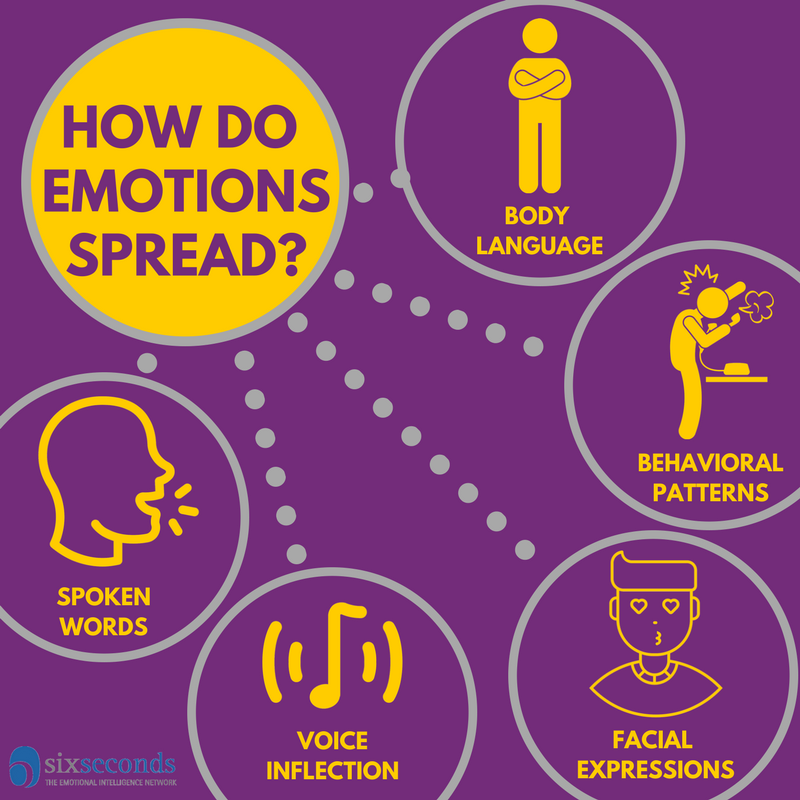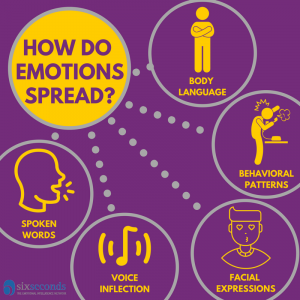“Emotions spread between people like a virus,” says Sigal Barsade, a researcher who has been studying emotional contagion for decades. But the question I want to look at in this article is, how exactly do they spread? And are we even aware that it’s happening?
Based on the latest research, here are 5 surprising ways emotions spread between people.
1. Not what you say, but how you say it. Voice inflection is one of the primary ways we transmit emotional data to other people, and they often “catch” the feelings that they deduce from our voice. Consider this fascinating study from social psychologists Roland Neumann and Franz Strack. In the study, participants listened to actors reading an impartial speech using happy, sad, and neutral inflections. Later on, the participants were asked how they were feeling.
And what did they find?
The participants’ moods largely matched those of the speaker they heard, and the group that heard the speak with the positive inflection reported feeling the most optimistic. And, when asked to rate how they felt about the speaker, participants liked the speaker with the sad voice least.
Another really interesting part of this study is that some participants were asked to read the speech after listening to the actors read it, and they spontaneously imitated the actor’s vocal expression of emotion.
So in some cases it’s not what you say – but how you say it – that is most important. People not only pick up on how we’re feeling from our voice inflection, but tend to start feeling that way themselves.
2. Teeny tiny facial muscle mimicry. Try saying that 10 times quickly. But it’s true, emotions spread quickly because of the tiny muscles in our face. When we have conversations with people, we are unconsciously mimicking micro movements of the other person’s facial muscles. This happens automatically in a matter of milliseconds. And different combinations of tiny muscle movements correspond to different emotions, which is actually the entire purpose of the mimicry. This involuntary mimicking activates a mental and emotional state that matches the other person’s. It’s actually a specific group of brain cells called mirror neurons that fire, which causes us to mirror their experience and feel what they’re feeling. And this all happens subconsciously!
From an evolutionary perspective, this mimicry mechanism is an amazingly rapid and accurate way to decode the other person’s emotional state. When you see a person who just saw a tiger, decoding quickly that the facial expressions you see are an expression of fear – and feeling it yourself – could have been the difference between life and death. That’s why we are so attuned to subtle movements of other people’s facial muscles, be it their lips, eyebrows, or eyes – it’s a survival mechanism for social creatures.
So the second of the 5 surprising ways emotions spread are through this unconscious imitating of others’ facial expressions. And in terms of amazing research on imitation and emotional contagion, we’re not done yet.

3. Just by thinking about Grandma. Just like we mimic facial expressions without realizing it, we do the same with other people’s body language and posture – and for largely the same reasons. But the research is really even more incredible than that. We not only mimic other people’s body language and posture when we’re with them – which activates those same mirror neurons – but also when we are merely thinking about a person or group of people associated with a particular type of movement. Consider this study from the University of California at Los Angeles. The participants gathered and were given different types of word association games, called scrambled sentence language tasks. It’s where you have a seemingly random group of words and try to make a sentence out of them, like “the in hole jumps a rabbit” or “like people play to elderly bingo.” The participants finished the task, then went on their way, probably assuming that the study was over. But in reality, it was only beginning. The researchers really wanted to know if the words the participants unscrambled would have any effect on them once they left, so they videotaped everyone walking to the elevator. And sure enough, guess what? The participants who unscrambled words about the elderly, like “Elderly people like to play bingo,” walked significantly slower to the elevator than the other groups, unknowingly imitating the slowness of old people. This is deeply wired into the human brain.
And once again, it’s the same evolutionary reason for imitating others. The purpose of it is to understand others’ emotional states more quickly. The muscle movements of imitating others – whether it’s tiny facial muscles or all the muscles involved in walking – trigger mirror neurons that help us feel what they are feeling.
It makes intuitive sense that how we speak and our body language transmits emotional data to other people, but this next one really blew my mind.
4. The sweet smell of stress. This is probably the most shocking of all the ways emotions spread. You can catch someone else’s emotions by the way they smell? Yes, you can, according to recent research from the Medical University of Vienna. In a laboratory setting, respondents could tell a discernible difference between the smell of stress sweat and exercise sweat. Furthermore, they found that smelling the stress sweat changed people’s perceptions of others’ warmth and competence. In the study, participants who smelled stress sweat rated people as less trustworthy and less competent than controls who rated the same people but not while smelling stress sweat. Now why would that be? Probably because of those same mirror neurons, who, when smelling the stress sweat, activated the regions of the brain associated with stress. And when we’re stressed, we release cortisol, which literally blocks the release of oxytocin, the trust chemical.
Emotions can spread through smell. Take a whiff of that.
And finally, where all things ultimately end up, Facebook.
5. The posts we see on Facebook. Many of these surprising ways emotions spread have to do with subconscious movements and imitation, verbal and nonverbal cues that go beyond the words themselves. But it turns out, emotional contagion can also happen based only on words. In a study conducted by Facebook, which was published in Proceedings of the National Academy of Sciences in the United States, Facebook manipulated users’ news feeds so they they saw mostly positive or mostly negative content. And users’ subsequent posts were either more positive or more negative, depending on which group they were in. The results suggest, in the words of the study, that “emotions expressed by others on Facebook influence our own emotions, constituting experimental evidence for massive-scale contagion via social networks.”
So all of these surprising ways emotions spread, what do they mean? That emotions spread through a number of mechanisms, most of which we’re not aware of as they are happening. So if you want to be sure that you are passing around what you want to pass around, the only real way to ensure that is to take care of yourself emotionally.
But the good news is, a little investment in emotional intelligence can go a long way.

- Pursue Noble Goals in the Six Seconds Model of EQ - July 29, 2023
- Increase Empathy in the Six Seconds Model of EQ - July 26, 2023
- Exercise Optimism - July 24, 2023


I loved reading your article. I am a teacher and mother and have often experienced this mirror imaging in my child and students. Thanks for stressing the importance of looking after one’ s well- being and trying to spead positivity, even if we are feeling tired or anxious. It makes such a difference.
Great article! Shows how, if we act intentionally, we can pass round what we want to pass round…working the room!
Thank you, Ruth! Imagine a world where we passed around what we wanted to pass around – even 10% more often. Powerful stuff!
I loved the article,it was so interesting as also an eye opener.Thank you for sharing.
Sarita
Thank you, Sarita! I’m glad you enjoyed it.
This explains why we tend to identify ourselves with the lead characters in movies that employ visual and auditory subteleties. Great orators form public opinion in their favour,may be because their methods of delivery are simply attuned to the inner needs of the audience.
Great articles. All politicians should learn about this as what they do will bring influence to the public.
Super insights, Michael ! in fact the smell of stress is what i learnt when I first brought home a pet and started studying how my doggy reacted towards visitors that were scared and kept away from them. Instantly they know , the people who like them and and are happy to see them. The smell of cortisol released during stress caused due to fear drives them away. The last point was something i didnt think of. Facebook one.. Thanks.. kanchan
Thank you, Kanchan. Yes, animals seem to be particularly tuned into smell as a transmitter of emotional data. In my work on farms, I have found this to be especially true of bees. If you are scared, they can smell that fear and are more likely to sense you as a threat, and be more aggressive. But when I am calm, they notice me less. How beautiful! Thanks for reading and sharing!